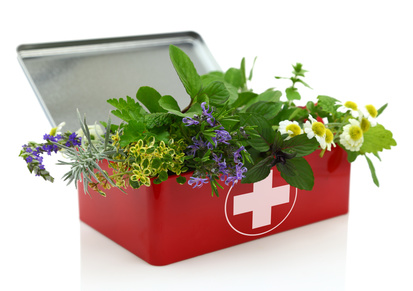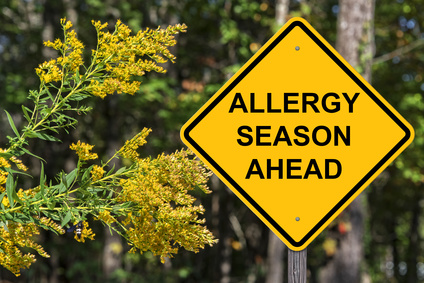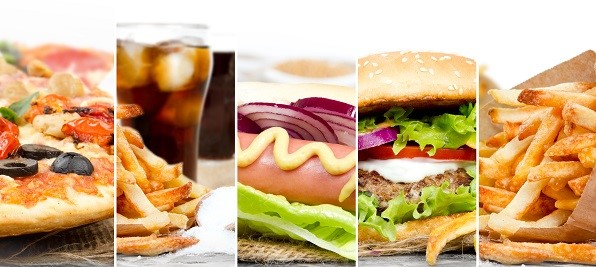Written By: Steven Horne
 People don’t get sick or injured at convenient times. You can’t always run to the health food store or herb shop when something happens. So, it’s wise to make up a home preparedness kit so that you have the tools on hand to be ready to take care of injuries and illnesses as they arise.
People don’t get sick or injured at convenient times. You can’t always run to the health food store or herb shop when something happens. So, it’s wise to make up a home preparedness kit so that you have the tools on hand to be ready to take care of injuries and illnesses as they arise.
You can put together your own herbal First Aid Kit and learn how to use it to handle common ailments and injuries. In this first part of this article you’ll find a list of NSP products I recommend for an herbal first aid kit. In the second part, you’ll find a mini-guide on how to use them.
Stocking Your First Aid Kit
Here are my recommendations for what to put in your home health care kit.
Capsicum Extract or Capsules: Capsicum is an important remedy for stopping bleeding, treating shock and stimulating circulation and healing. It is also a valuable remedy for colds and has mild analgesic qualities.
Lobelia Essence: Lobelia is an antispasmodic that relaxes muscle cramps or spasms and can be used to ease pain, relax the body during anxiety attacks and stress, ease asthma attacks, and relieve tension headaches. Lobelia can also be used as an emetic to induce vomiting in cases of food poisoning or flu. Blue Vervain is a milder alternative some people prefer for young children (no longer available).
Ultimate Echinacea or Immune Stimulator: It’s good to have something to stimulate the immune system to help fight off contagious disease when it’s “going around.” Ultimate Echinacea is a liquid immune booster, suitable for young children and adults. Immune Stimulator is an encapsulated remedy for older children and adults who can swallow capsules. These remedies can not only help prevent infections, they can also boost your immune system to fight them off more effectively.
Silver Shield and/or Silver Shield Gel: I keep both of these in my first aid supplies as natural antiseptics. Silver Shield is a very effective and nontoxic silver product that can be taken internally or applied topically. You can use it as a sinus spray, throat gargle or as ear drops for infections in the sinuses, throat and ears. It can also be taken internally for infections, but I have better results with other remedies for colds, flu and other acute ailments. The gel is excellent for all topical applications and is safe to use on open wounds. It can also be used as a hand sanitizer.
Activated Charcoal: Every home should have some activated charcoal on hand for use in case of poisoning, especially if there are small children. It lasts forever, so there is no worry about it going bad on you. You can take it to absorb toxic substances, but you should call a poison control center for advice. It can also help with severe intestinal gas and bloating and diarrhea. It can be mixed with aloe vera gel or silver shield to make a poultice for spider bites. Activated charcoal can also be applied as a poultice to draw pus and infection out of wounds.
Tei Fu Oil or Tei Fu Massage Lotion: Tei Fu oil is a topical analgesic and can be rubbed in to ease the pain of headaches, muscle aches, arthritis, sore throats and much more. It can be inhaled for respiratory congestion and makes a great remedy for bites and stings. I’ve also rubbed it into the chest for congestion. I think it’s one of the best topical analgesics on the market.
Peppermint Oil: Peppermint oil settles the stomach where there is nausea and vomiting and eases gas and bloating. It can also help to promote mental alertness.
Distress Remedy: In any injury or emergency situation there is going to be stress. Distress Remedy can be used to relieve both physical and emotional shock and help a person be more calm and centered following an injury or a severe trauma. It can also be applied topically to speed the healing of minor injuries. Because it is sticky (due to the glycerin in it) you may wish to dilute it with a little alcohol for topical application.
AL-J Liquid or Capsules: If you are prone to colds and respiratory congestion, this is a great remedy for clearing mucus from the lungs and sinuses. It is useful for coughs, colds, earaches, digestive upset and allergies.
Aloe Vera Gel or Herbal Trim Skin Conditioner: A high quality aloe vera gel is useful to keep on hand for burns, sunburn, abrasions and other skin irritations. Herbal Trim Skin Conditioner works even better than plain aloe vera gel.
IF Relief: No first aid kit is complete without something for pain. This natural anti-inflammatory is a great remedy for easing pain and promoting recovery from minor injuries, headaches and other aches and pains.
Golden Salve and/or Black Ointment: Golden Salve is a soothing salve that promotes rapid tissue healing and can be helpful for reducing swelling and promoting healing of bumps, bruises, sprains, pulls, torn ligaments and other injuries. Also consider Black Ointment, which can help draw out pus and infection.
Nature’s Fresh: This product is great to have on hand for stains and odors, but is also an amazing topical spray for helping to ease pain and promote healing. Spray it on all kinds of minor injuries and painful areas to ease pain and promote healing.
Other Products: You should also add to your first aid/emergency kit other products for the specific needs of yourself and your family. For instance, I also like MSM/Glucosamine cream for pain and VS-C for chronic viral infections.
Other Items: Of course you should also include standard first aid items in your kit, such as an assortment of bandages, gauze pads and other dressings for wounds, a pair of tweezers and a needle for extracting slivers and a small pair of scissors. Splints and elastic wrap bandages are handy for breaks and sprains. Hot and cold packs are also useful. A flashlight that you can put on your head so your hands are free is a great item, too.
I keep my home health care kit in a large tackle box. This gives me various compartments for bandages, herbs and other supplies, making them easy to locate. I think of it as my home health care toolbox. I also have a lot of first aid supplies in a small back pack that I can pick up and use to help people in emergencies.
Your Mini First Aid Guide
There are numerous natural remedies for all of the following situations. However, we have limited our recommendations to those remedies in our suggested first aid kit. That way, you can put this mini guide with your kit and use it for a quick reference when needed.
Abrasions and Scratches: Any of the following can be applied topically to abrasions, scratches and similar injuries to prevent infection, ease pain and/or promote healing: Aloe Vera gel, Silver Shield, Nature’s Fresh and Tei Fu Oil.
Asthma Attack: Lobelia acts as a bronchial dilator and can be used in cases of asthma attacks where other medications are not available. Administer doses of Lobelia Essence every two minutes (about 1/4 teaspoon) until the attack subsides. This may cause vomiting, but will ease the attack.
Anxiety Attack: Administer small doses (5-20 drops) of lobelia every 2-3 minutes while encouraging the person to breathe slowly and deeply. Distress Remedy is also helpful for anxiety attacks. (Joy suggest adding REFUGE Calming Blend EO)
Bites and Stings: Insect bites and stings can be treated with a wide variety of remedies. Tei Fu oil, Lobelia and Nature’s Fresh are all remedies that can reduce swelling and ease the pain of insect bites and bee stings. For poisonous spider bites, apply a poultice made of activated charcoal and seek medical assistance. Also seek assistance for allergic reactions.
Bleeding: To stop external bleeding, apply pressure directly to the wound. You can also sprinkle capsicum into bleeding wounds to help stop the bleeding. Capsicum can be taken internally to help stop internal bleeding, too. Of course, seek medical help for internal bleeding.
Blisters: Apply remedies like Tea Tree oil, Golden Salve, Silver Shield and Aloe Vera Gel topically to blisters and cover with a bandage to promote healing.
Bumps and Bruises: Golden Salve can be applied directly to bumps and bruises to rapidly reduce swelling and ease pain. You can also hold or rub the afflicted area for 5-20 minutes to take down swelling even more rapidly. Tei Fu oil or Nature’s Fresh may also be helpful.
Burns and Scalds: First degree burns involve redness, pain and swelling; second degree burns cause blisters. You can treat both first and second degree burns by applying cold water immediately to the burned area to cool it down. You can also dress the burn with Aloe Vera Gel to soothe pain and cool the burn.Nature’s Fresh and Silver Shield also make useful burn remedies
Two other good burn remedies you will probably have in your kitchen include real vanilla extract (not imitation) and raw honey. Both ease pain and promote rapid healing. IF Relief can be taken internally for pain. For third degree burns, which involve charring of the skin, seek medical attention.
Colds: At the first sign of a cold, stop eating and start drinking lots of fluids. Take remedies to clear congestion like AL-J or Capsicum. You can use Ultimate Echinacea, Immune Stimulator or Silver Shield to help the body fight the infection. It is also helpful to rub Tei Fu oils topically into the chest and throat or inhale them into the sinuses.
Canker Sores (Mouth Ulcers): A small, painful mouth ulcer usually is called a canker sore. Apply Tei Fu oil or Peppermint oil directly to the sore to ease pain and promote healing.
Cramps and Spasms: Lobelia is excellent at relieving cramps and spasms. It can be taken internally, but works even better when the extract is applied topically mixed with equal parts capsicum extract. This draws blood into the afflicted area and relaxes muscles.
Cuts: Styptics are herbs, usually astringents, that have the power to stop bleeding, close cuts and speed the healing of cuts. Capsicum is a useful styptic. Silver Shield or Silver Shield Gel is a good remedy to apply to cuts to prevent infection.
Diarrhea: Activated Charcoal makes an excellent remedy for diarrhea. It absorbs substances that are irritating the colon and firms up the stool. You can also take infection-fighting remedies such as Silver Shield, Ultimate Echinacea and/or Immune Stimulator internally if the diarrhea is caused by infection.
Ear Infection or Earache: Two remedies which make good ear drops for ear infections are lobelia (which eases pain) and Silver Shield (which fights infection). Before putting these into the ear they should be warmed to body temperature. You can do this by putting the bottle into a cup of warm water or holding under your armpit or some other warm spot of your body.
Here are two other simple home earache remedies. One, cook an onion and put some body temperature drops of the juice from the cooked onion in the ear. Two, cut a clove of garlic in half, coat it with olive oil and place it on the outside of the ear.
Internally, AL-J, Ultimate Echinacea or Immune Stimulator can be helpful for earaches. It is also a good idea to avoid wheat and dairy foods in children with frequent earaches.
Food Poisoning: You can induce vomiting by taking large quantities of lobelia or you can take activated charcoal to absorb toxins (or both). Silver Shield will help fight the infection and Peppermint Oil will help settle your stomach (after you throw up). Seek medical assistance if the problem is severe.
Frostbite: Sprinkle tiny amounts of capsicum in socks or gloves to prevent frostbite. Warm areas affected by frostbite in cold water and seek medical attention.
Headache (Sinus): Headaches in the frontal region of the face are usually caused by congested sinuses. Inhale Tei Fu oils, take AL-J internally or spray Silver Shield into the sinuses to help decongest them. Drinking several glasses of water may also help.
Headache (Tension): Headaches involving a sense of pressure and tension can be eased by massaging the neck and shoulders using Lobelia and Capsicum and following this with Tei Fu oil. You can take lobelia internally to relax muscle tension or use IF Relief as a pain reliever.
Nausea and Vomiting: Peppermint oil can be used to settle the stomach in cases of nausea and vomiting. Lobelia in very tiny doses (2-3 drops) can do the same thing. Large doses of lobelia induce vomiting.
Pain: Remedies in the first aid kit that can be helpful for pain include IF Relief and Lobelia, which can be taken internally. You can also apply Tei Fu oil or Lotion, Peppermint oil, Nature’s Fresh, Golden Salve, Aloe Vera Gel or Lobelia and Capsicum mixed topically for pain.
Poison Ivy or Oak: Wash thoroughly after exposure. Aloe Vera gel or Silver Shield gel can be applied topically to aid healing.
Shock: Shock is a response to severe physical or emotional trauma and is characterized by paleness, rapid but weak pulse, rapid and shallow respiration, restlessness, anxiety or mental dullness, nausea or vomiting associated with reduced blood volume and low blood pressure and subnormal temperature. Cover the person to keep them warm, elevate their feet and give them Capsicum or Peppermint oil. They can also inhale Tei Fu oil.
Smashed Fingers: Grab and hold the finger tightly until the pain subsides (about 5-20 minutes), then apply Golden Salve or Nature’s Fresh. Tei Fu oil can also help.
Sore Throat: You can gargle with Silver Shield and/or Capsicum extract diluted with a little water or spray Silver Shield directly on the throat. You can also rub Capsicum and Lobelia,Tei Fu oil or Silver Shield Gel on the outside of the throat.
Sprains and Pulls: Nature’s Fresh is an excellent remedy to apply topically to help sprains heal. You can also apply Capsicum and Lobelia. IF Relief can be taken internally to ease pain and promote healing.
Sunburn: Aloe Vera gel, Herbal Trim Skin Conditioner and Nature’s Fresh are good remedies to apply topically for sunburn.
Wounds and Sores: Remedies that can help various kinds of injuries and sores to heal faster include Aloe Vera gel, Golden Salve, Ultimate Echinacea, Nature’s Fresh and Silver Shield.


